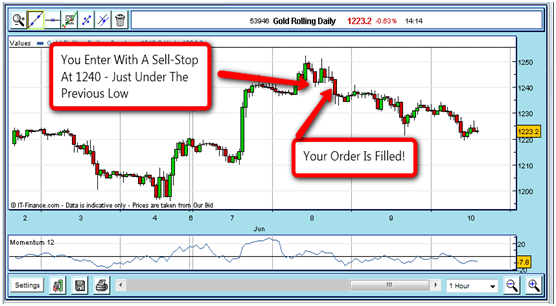Using A Stop To Enter A Spread Trade
This is a method I use often, and I encourage you to learn how to use it, because it can get you into good trades when you are away from your screen.
Let’s say you are following the Gold market and are looking for an entry. Because you are a disciplined trader, you just do not jump in after reading an article or a blog post! You study the market and begin using your skills (to be learned in the next few sections).
Your analysis leads you to believe that Gold is due for a big move down after rallying for some time. The market is at $1250, near its all-time high, but is losing upside momentum (using your momentum indicator). You decide that if the market falls to $1240, it will confirm the top and lead to further selling. You would place a sell-stop at $1240 area to enter a short trade. At the same time, you would place a protective buy stop above your entry price.

Now, if you wanted to be short, why would you want a worse price when shorting? Surely, it is better to get in at $1250, isn’t it? Well no, and that goes against our normal thinking. When selling our car, we want the highest possible price, don’t we?
This highlights that trading the financial markets requires a totally different way of thinking to the ‘obvious’ way. And this is one of the main reasons so many traders fail – they fail to make the adjustment to the mind of a trader.
When the Gold price is at $1250, most traders are not considering doing anything different, as it remains in an uptrend. But if it drops to $1240, many will think – ahah! It has topped out and I want to sell (either to protect profits on a long position, or to establish a new short), so selling pressure should intensify at $1240. When that happens, prices may well decline further, thereby confirming the new downtrend. That is how big market turnarounds get started.
Trading is all about being eagle-eyed about what the other traders are about to do, and getting in early (but not too early). That is the basis of technical analysis. We are looking for what the other traders are likely to do, and anticipating it.
Many times, it is just not possible to watch every tick of every market you are following, so use these entry stop orders, which you can place way ahead of a likely fill.
Think of the market like a train waiting to leave the station. We want to get to our destination (making a profit), but we don’t know where the train is headed. Then, the train leaves and heads along one particular set of tracks. That is when you need to jump on board, as the train has tipped its hand as to where it is headed. It is far better than guessing!


Join the discussion